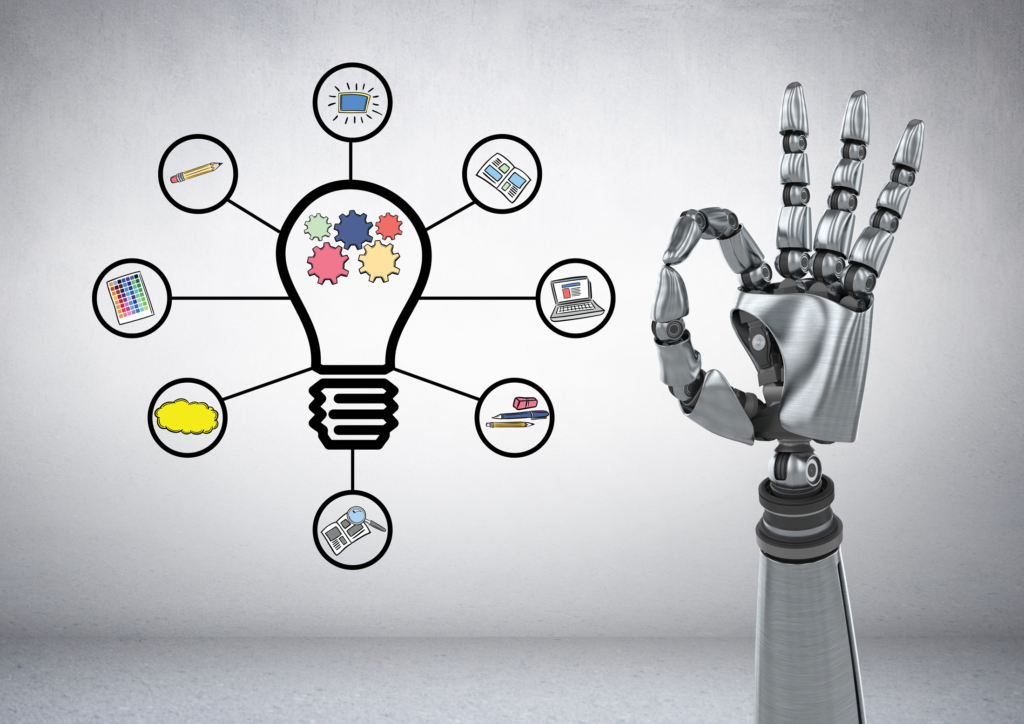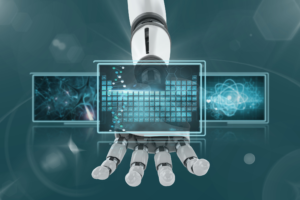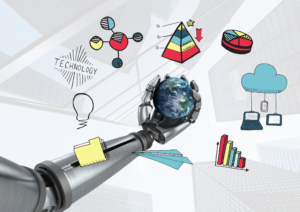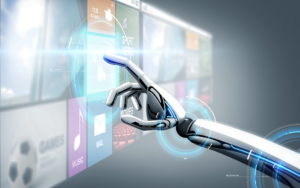Machine Learning and eLearning – How Adaptive Learning can Flourish with these Technologies

Education is moving away from passive learning and content-centered instructions to a more active learning experience, where learners interact with technology and make sense of information through social and constructive learning strategies. In this post, I will explore the technologies of machine learning and eLearning, and how they can interact to make learning processes even more efficient and adaptable to the different needs of learners.
What is Machine Learning?
Machine Learning (ML) is a subset of Artificial Intelligence that uses statistical techniques to give computer systems the ability to “learn” from data previously collected.
Back in 1959, MIT engineer Arthur Samuel coined the term and defined machine learning as a “field of study that gives computers the ability to learn without being explicitly programmed.”
Machine learning is not something that is going to happen in the future. We are already surrounded by machine learning. If you are using Facebook, Instagram or any social media, and you see a recommendation for a particular hashtag, a person or a social media account to follow, then you have experienced machine learning.
Essentially, machine learning algorithms sort through large amounts of data and enable technology to make predictions based on patterns found in that data.
Other examples of machine learning that are common these days, are the recommendations on Netflix and Spotify which, based on your previous selections, they make recommendation of new content.
How can Machine Learning be used in education?
Due to the learning ability of this technology using data and discovering patterns, machine learning could drive the implementation of adaptive learning functionalities in Learning Management Systems (LMS).
Some examples of adaptive learning functionalities are:
- Enable educators and instructors to see where, when and how learners are engaging with content.
- Guide the curation and recommendation of associated learning content and social media feeds.
- Predict how a learner might score on an assessment based on past behavior.
- Recommend new courses and learning materials based on previous performance.

What is Adaptive Learning?
Adaptive learning is a trend in education that promotes the personalization of learning content using appropriate technology, such as Machine Learning. Adaptive learning is the strategy of adjusting the path and pace of learning to each learner’s needs.
Personalized learning improves a learner’s ability to retain information, increases engagement and motivates a student to master tough concepts. When learning is tailored to an individual’s strengths and is focused on their success, the learner is more likely to actively engage in their education (Wright, 2017).
Some benefits of adaptive learning are:
- Shorter training time because learners will do only what is relevant to them.
- Increased in Return of Investment (ROI), because learners will spend less time taking training that doesn’t apply to them.
- Identification of skills gaps and competencies in a more efficient way by tracking which courses are delivered more often and which aren’t.
- Personalized training paths for each learner which increases motivation.
What does eLearning have to do with Machine Learning and Adaptive Learning?
Machine learning technology and its algorithms that collect data to detect patterns and behaviors can be incorporated in eLearning through Learning Management Systems (LMS) to create adaptive learning solutions.
Learners can now login in their LMS, have a personalized learning path with specific courses relevant to their particular needs. Also, learners will do those courses online on their own time and will receive targeted reports to boost their performance.
On the other hand, instructors and educators will run specific reports with more accurate data on what are the courses more popular among learners, at what time are they doing the courses, what is the performance of learners based on assessments results, in which online assessments are learners scoring higher points and other behaviors relevant to the online instruction.
Based on all those interactions and data, instructors can provide their input to keep customizing the learning experience to continue adapting the materials and assessments to the learners’ needs.
Applications of Machine Learning in Education
Some specific applications of machine learning technology in education are:
Support educators: Educators can access all learners’ data in one place. In addition to carrying some of the administrative weight, machine learning also helps educators improve their lessons by identifying the assessments where learners are struggling the most.
Predict learner performance: By “learning” about each student, the technology can identify weaknesses and suggests ways to improve, such as additional practice tests.
Test learners: Machine learning can help move away from standardized testing. With machine learning there is constant feedback to teachers, students and parents about how the students learn, the support they need and the progress they are making towards their learning goals.
Grade fairly: The automatic evaluation process is an advantage of machine learning. This will be an opportunity for completely unbiased grading that cannot be influenced by any external factors. It gives a more realistic view of student’s progress and achievements.
Provide customized learning: As mentioned previously, machine learning also makes it possible to customize learning for each student. Educators will be able to use the data to see which students need additional assistance, and the technology can also suggest meaningful learning tools for each student.
An individual learning path allows learners build their knowledge progressively through learning materials or sequence of courses. Personalized learning paths emphasize learner specific goals and preferences.
Organize content effectively: Through identifying weaknesses, machine learning can organize content more effectively to present the learning materials in such a way that will promote scaffolding techniques. For example, as students learn one skill, they move on to the next skill continually building upon previous knowledge.
Improve retention: Learning analytics tools available with machine learning, will also help improve retention rates. By identifying “at risk” students, educators can reach out to those students and get them the help they need to be successful.
Chatbots: This tool provide conversational answers and serve as quick reference guides. Bots also reinforce the learning experience by imparting relevant information when needed. Chatbots can be programmed based on data gathered with machine learning algorithms.

Keeping a human in the loop
But please, don’t worry with all this technology. Humans, real educators and instructors are still needed 😀
“Human-in-the-loop” is a branch of Artificial Intelligence that marries the best of human and machine intelligence to bring better machine learning models.
In a traditional human-in-the-loop approach, people are involved by training, tuning and testing a particular machine learning algorithm.

Other functions of humans-in-the-loop are:
- Define the specific questions that are relevant to improve the learning experience. For example: which learning resource are learners using? The machine learning technology will help answer this, but the educator needs to establish the questions in advance.
- Analyze the data. Educators will have to interpret the data collected in the reports generated by machine learning. Find the story and behavior behind the data, the trend, do an analysis. Data may show what learners are asking to the chatbot, the time, the frequency. But educators need to make sense of the data, ask learners, find the rationale and use that information to fine tune the algorithms.
- Provide human perspectives and knowledge when patterns emerge. The input of educators is a vital part of machine learning processes for building better algorithms.
- Data scientists is a career that will have more and more demand. They can help explore and interact with machine learning reports, data and algorithms within the learning solutions.
In Summary
We don’t need to panic, educators, instructional designers, we are all needed to fine tune these technologies and to provide the human touch, perspective and knowledge to the learning experience.
What we should do is to embrace, learn and be prepared to incorporate machine learning capabilities into the learning solutions we create to move more to an adaptive learning approach that will, at the end of the day, benefit our learners.
Promoting adaptive learning techniques into eLearning will motivate more our learners because they will have a sense of personal treatment when doing the courses. It is like providing a VIP service to our learners.
Machine learning helps educators to look forward to the future and will help us all in solving academic issues with the data collected. This technology will help us in identifying when students are at the risk of dropping out, so we can act and help them.
Machine learning also provides a more effective way to analyze learner engagement data and identify patterns for content redesigning. And that’s what we want, information to improve our learning solutions so we can help our learners.
Do you think this technology is enhancing education? Feel free to leave your comments below.
See you next time,
Thais 🙂
References
Banner, P. (2019). The human side of machine learning. [Web]. Retrieved from https://pubs.royle.com/publication/?i=554422#{“issue_id”:554422,”page”:18}
CIO Applications. (n.d.). How machine learning will shape the future of e-Learning. [Web]. Retrieved from https://www.cioapplications.com/news/how-machine-learning-will-shape-the-future-of-e-learning-nid-3106.html
Ivec, S. (2019). E eLearning trends to look for in 2019. [Web]. Retrieved from https://elearningbrothers.com/blog/3-elearning-trends-to-look-for-in-2019/
Lynch, M. (2018). 8 Ways machine learning will improve education. [Web]. Retrieved from https://www.thetechedvocate.org/8-ways-machine-learning-will-improve-education/
Wright, J. (2017). Personalized learning: the key to retention, engagement and mastery. [Web]. Retrieved from https://trainingmag.com/personalized-learning-key-retention-engagement-and-mastery/

18 Responses
With technological advisement, machine learning was and inevitable outcome.
Much as you note that the humans will be left in the loop, I foresee machines dominating in the future.
I imagine the cost of adopting machine learning could be steep to allow its quick adoption all over the world.
Thank you Thais for this informative post.
It is unreal right? If these codes and algorithms keep learning and learning they might replace us completely. It is scary. I guess my kid should study programming or robotics or maintenance of robots 🙂 thanks so much for your comment.
Hi there 🙂 Wow, I am interested in modern technologies, but I didn’t expect how widely it can be used. Especially programs which will help students. This is incredible for all of us. I am struggling now with my exams and I will try to check them. Thank you very much for your work with this article.
Thanks so much for your comment 🙂 yes indeed these technologies have so many application in different fields.
This is an eye opener; the article and reviews are well explained. mechanical learning is the major key and our everyday activities is dependent on it. the major needful that has to be put in place is learningOur major target or responsibility should be focused on improving ourselves on daily basis.
Yes I think technologies are helping us in so many different ways that we will have more time to concentrate on other things, like you said it could be on improving ourselves, our families, the environment. Hopefully everything will be always for a better future.
I am always astonished as the level of achievement under Artificial intelligence and the research outputs. It’s always cool to experience ease and comfort with A.I in relation to leaning but then I must ask you about the impact of this machine learning and e-learning on job opportunity in the future because if it seems that machines does all these for we humans, we’ll only be left with little or no more roles to play.
Hi Salim, this is a valid concern that I have too. When I was researching this topic I read that machines will design and develop instructions and eLearning and I was like OMG :O what is going to happen with my role? How can I compete with a machine? But our roles keep changing and evolving. I guess we will still human educators to validate machines, test, fine tune algorithms and make sense of the data. Thanks for your comment 🙂
Without open mind and a lot of research, it is easy to conclude that the machine learning and artificial intelligence are going to be a great threat to human. One thing that this scholarly article has pointed out is the fact that human can use these technologies to their advantage, to improve the educational system and help students in a point where they are weak the most. I will say YES, technology like this will go a long way in enhancing the education.
Thanks so much for your comment 🙂 it will enhance for sure, hopefully we will be able to fine tune machines to continuously improve processes.
Hi Thais! This is interesting. I am surprised to know that following someone on social media, or hashtag are part of machine learning. I used to associate machine learning in Artificial Intelligence as strictly as data collected from professionals in various field and stored in knowledge based domain through which statistical inferences can be drawn. You are right that inspect of all the wonderful technologies, human educators are still much more needed. It is simply important that these technologies be adopted in the teaching and learning process to aid understanding and make students keep abreast with the fast rate of technology development. Thanks for your informative article.
Thanks so much for your comment 🙂 yes it is amazing to think that we are already experiencing machine learning. All these technologies, apps we use on our lives are already collecting data on our behaviour and identifying patterns. There are lots of big data already out there 🙂 hopefully to aje things better and not for detrimental purposes.
Thank you for this post on machine learning and eLearning, this is super exciting and soon the computer will be very much more clever than us, When the computer goes quantum, we could all benefit from this both in learning but also in many other areas. No human teacher, lawyer or doctor could scan and compare millions of documents in a matter of seconds. I am not afraid that the machine could turn evil I’m more scared of those owning the machine will get super rich, and leave the rest of us poor and unemployed. But if we let the computers work for us ALL we will have a bright future doing more of what we love and spending time with those we love and only work a little.
Thanks so much for your comment! Yes you are right. How can we compete with machines. I guess I’ll have to learn how maintain and fix machines and algorithms 🙂 that might be a job in high demand 😉
Machine learning is gradually here to stay in out world, I think people should start diverting their attention to start learning robotics and programming. But on the Contrary it make me feel insecure that one day there will be no job out there for people because technology will have taken over.
I know, I have the same concern. I’m always recommending people, especially the young, to study programming and robotics. But I’m also wondering, what about me? I still have like 35 years of working life, what will I do? Hopefully educators or “human educators” will still be needed 🙂 maybe the “human touch” will become in high demand in the future 😀
Hello Thais,
It is incredible the advancement of technology when you mention automatic and adaptive learning. In the automatic it draws heavily on the recommendations made on various social networks, benefiting both teachers and students.
In contrast, the adaptive is more personal, takes into account the needs of the person. What motivates him to achieve more effective learning.
Thank you very much for the excellent information you have given us.
Thanks so much for comment and for sharing your views on the benefits of these technologies 🙂